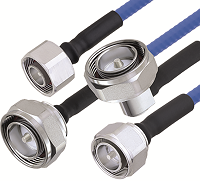

Passive intermodulation (PIM) distortion is the result of discontinuities, metal-to-metal contact, and material properties that lead to nonlinear characteristics of typically linear passive transmission lines and components.
PIM can be induced in a variety of RF components, such as connectors, adaptors, cable, combiners, splitters, couplers, tappers, attenuators, terminators, antennas and cable-to-board interconnect.
PIM is generated when two or more signal components at different frequencies interact at a non-linear junction and create a distortion product from frequency mixing. PIM becomes an issue when the distortion product of a transmission is either reflected back toward a sensitive receiver and is in the receive band, or a distortion product is transmitted and received by nearby communication systems susceptible to the particular distortion product. Due to the passive mixing of PIM generators, the power levels produced by PIM generators is generally weak, and only higher-power transmission signals tend to generate PIM power levels that are significant.
In years past, PIM issues were avoided by choosing frequency bands and filters that mitigated the amount of PIM that could impact receive bands. However, modern cellular, Wi-Fi, emergency/public service bands, new 5G cellular bands, ISM bands, TV white space bands, and other wireless services are often used in conjunction, especially with distributed antenna systems (DAS).
Many DAS are designed and installed to carry multi-band signals, either from a variety of cellular carriers, emergency/public safety, Wi-Fi, and other building automation services. Hence, the antennas, amplifiers, filters and transmission lines for DAS are all designed to operate over a wide range of sub-6 GHz frequencies, which is subsequently where the most spectrum congestion is and the greatest harm from PIM can occur. With multi-carrier systems PIM products can potentially be created by the mixing of any combination of signals and have a higher chance of landing in the bandwidth of sensitive wideband receivers.
Narrowband systems are less susceptible to PIM, as the passband of the receiver tends to be very narrow, so a precise combination of signals is necessary to create a PIM product that lands in that narrow bandwidth. However, with modern highly modulated wideband communication systems, such as 4G LTE, Wi-Fi, and new 5G NR sub-6 GHz frequency bands, receive bandwidth is much wider, and the heavily modulated wideband signals also generate much wider-band PIM products than narrowband signals.
For example, if the fundamentals from the two mixing signals is 10 MHz, then the third-order product will have three times the bandwidth (30 MHz) and the fifth-order product will have five times the bandwidth (50 MHz). With heavily modulated wideband signals, especially those that use spread spectrum techniques, the receive signals are often very weak, and PIM products that overlap with the receiver bandwidth could easily desensitise the receiver and dramatically disrupt communications.
PIM considerations specific to DAS
With DAS, another large PIM concern is the metallic structures within buildings, transportation stations, stadiums, etc. that are nearby the remote radio heads (RRH) or distributed antennas. If there are any metallic structures within a few wavelengths of the antenna, then reflections with distortion products could be received by the antennas, amplified, and carried to a receiver.
There are a variety of low-PIM antenna technologies, as well as quasi-omni antennas and the use of multiple directional antennas precisely positioned to have antenna patterns that avoid PIM generators in the environment. Also, many DAS installation mechanisms allow for changing the position of a RRH or antenna by tens of centimetres, which can significantly reduce the strength of environmental PIM generators.
Moreover, PIM transmitted and generated within the environment by other RRH, DAS antennas, and other wireless communication systems could also impact wideband DAS in hard-to-predict ways. The reason multi-carrier and multi-frequency systems are more challenging to predict is that with each additional signal, the mixing products become much more complex.
There are additional temporal considerations for PIM in DAS systems, as the environment and signals around the DAS are likely non-static. Hence, changing environmental components could lead to PIM generated at different times and in impossible-to-diagnose situations. Therefore, it is often beneficial for DAS installers to ensure that the entire system exhibits as low an internal PIM level as possible, which makes detecting, identifying and troubleshooting external PIM factors easier and more reliable.
Another area of concern for DAS systems and PIM are the large amount of connectors, adaptors, combiners, splitters, couplers, hybrids, attenuators, and other passive components that are often installed in-line to the transmission path. The cables, interconnect, connectors, and metallic features of any of these components could generate PIM, and unless they are tested once installed, their installed PIM performance may be very different than what is indicated on the datasheet.
This is especially a concern for components with ferromagnetic and ferrimagnetic elements. Though ferromagnetic metals and components can be avoided with PIM-susceptible systems, it is often difficult to avoid ferrimagnetic components, such as isolators, circulators, and phase shifters, which tend to produce higher levels of PIM than other components.
Also, the proximity of a component to a signal source impacts the strength of the distortion products generated. Therefore, placement and planning of connectors, passive, and even active components, can have a significant effect on the amount of PIM reflected back to the receiver.
Another important factor to consider is superposition, in that every distortion product that is generated will form a compound reflected signal. With complex DAS, this could lead to several distortion products within the receiver’s bandwidth combining power, which makes such complex multi-carrier DAS systems even more susceptible to PIM with increased opportunity for higher-power distortion products from combinations of even low-power transmissions.
For more information contact Andrew Hutton, RF Design, +27 21 555 8400, [email protected], www.rfdesign.co.za
| Tel: | +27 21 555 8400 |
| Email: | [email protected] |
| www: | www.rfdesign.co.za |
| Articles: | More information and articles about RF Design |

© Technews Publishing (Pty) Ltd | All Rights Reserved